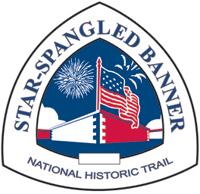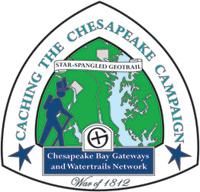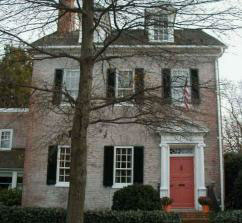SSB - Chesapeake Bay Maritime Museum Traditional Geocache
SSB - Chesapeake Bay Maritime Museum
-
Difficulty:
-

-
Terrain:
-

Size:  (regular)
(regular)
Related Web Page
Please note Use of geocaching.com services is subject to the terms and conditions
in our disclaimer.
During the first challenge along the Star-Spangled Banner GeoTrail, over 400 first edition SSB geocoins were awarded. We would like to thank everyone who participated in the Star-Spangled Banner GeoTour. We are currently out of geocoins but stay tuned for other opportunities along the Star-Spangled Banner GeoTour!


Come on a journey to remember and commemorate the dramatic chain of events, people and places that led to the birth of our National Anthem.
The story of the Star-Spangled Banner was shaped by the events of the Chesapeake Campaign during the War of 1812. From February 1813 until February 1815, the Chesapeake Bay was the center of a fierce struggle between the British and Americans. Places and landscapes still exist today that provide a touchstone to the past. The trail traces events and related sites that figured prominently in the Chesapeake Campaign of the War of 1812 that have national significance, physical integrity, and the potential for contemporary recreation and interpretation.

You are seeking a traditional camo'd hide. The cache is hidden in the "no fee" area of the museum, accessible from a paved walkway.
Everyone remembers the story of Fort McHenry and the Star-Spangled Banner as a singular event in the War of 1812 that saved Baltimore and contributed to preserving American independence. We also celebrate those regional movements, local events, and individual achievements that contributed to forming or preserving our freedom.
The St. Michaels story is an example of this: “The Town that Fooled the British,” following a tradition that the town was saved from destruction by cannonade by hanging lanterns in the trees and decoying the fire.
From the accounts of the British and American commanders and a contemporary report in a Baltimore newspaper, we can piece together this story:
In the rainy, foggy, early morning hours of August 10, 1813, the British 14-gun brig Conflict advanced up the Miles River, and eight smaller boats with a landing party came ashore somewhere along what we call Rio Vista, just south of the harbor. Their stated target was a couple of armed vessels on the “St. Michaels River” (now called Miles River) and an armed battery—no explicit mention of a town or shipyards. The landing party advanced on a battery at Parrott’s Point, guarding the mouth of the harbor and briefly exchanged fire with the defenders. The defenders at Parrott’s Point, commanded by Lt. William Dodson fled to the town, where two more artillery batteries and the rest of the 500-man militia were assembled. After dawn, the British landing party returned to the boats, and then proceeded to exchange fire with the defenders in the town. The newspaper account reported “We were fortunate not to have a man hurt, although the grapeshot flew like hail in the town, and their balls passed through a number of houses.” Gen. Benson confirmed in his report, “Some of the houses were perforated, but no injury to any human being.” The British soon retreated with no boats sunk and two men wounded.
The British, although overstating a success in destroying a battery “of six guns—12 and 6 pounders,” clearly were dissatisfied and attempted to march on St. Michaels from the direction of Claiborne 13 days later. Again, with fog confusing their advance, they turned back before reaching the town.
Two sources tell about lanterns as part of the story, but these sources were written down long after the event. One is an account given to a Baltimore newspaper in 1890 by Thomas Kemp, who had been about 13 years old at the time of the battle. He stated that “Lights were placed at night upon trees and masts of vessels.” Leonidas Dodson, a son of battery commander William Dodson elaborated slightly, “Happily the fire of the enemy went over the heads of the defenders due to the sagacity of Gen. Benson who had ordered lights placed at great elevations.” (Great elevations are relative on the Eastern Shore.) At about the same time, a grandchild of the Merchant family recorded the story about a cannonball hitting the Cannonball House, confirming Gen. Benson’s account that “several houses were pierced.”

Cannonball House
At this late date, we cannot know why official accounts do not mention the lanterns. Were the lanterns ineffective because the cannonade took place after daybreak? Or were the lanterns only an afterthought by the defenders—and therefore not worth mention in official accounts? At least one historian has suggested that there were no lanterns at all, but the story was elaborated later.
America was still a young nation in 1813, and still in the process of forming its identity. Part of this identity is the story of how we bought and preserved our independence. Local accounts like this battle of St. Michaels were an integral part of that formation of American identity. Today our culture is deeply concerned with fact and truth, and we resent fabrication and spin; we condemn those who violate strict standards for integrity. But the art of storytelling in the formation of historical narratives was much more accepted in the 19th century. Myth has such a negative connotation today, suggesting a mere fabrication, but it really refers to our founding stories, our explanations for why things are the way they are. And the creation of historical myth was an important step for us in telling the world, and telling ourselves, who we are as Americans.
In a small way, near this spot, Americans stood up and faced the enemy. That’s something to celebrate.

Thanks to HiTechMD for helping with this hide and to the Maryland Geocaching Society for assisting with this project!
Additional Hints
(Decrypt)
Obzof njnl